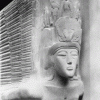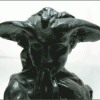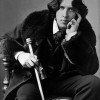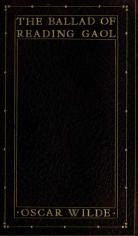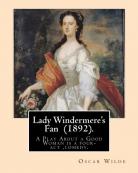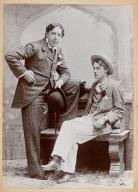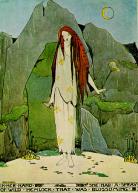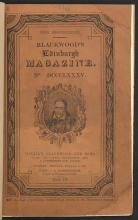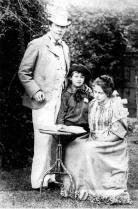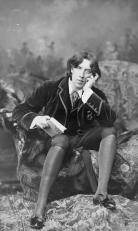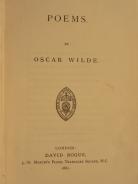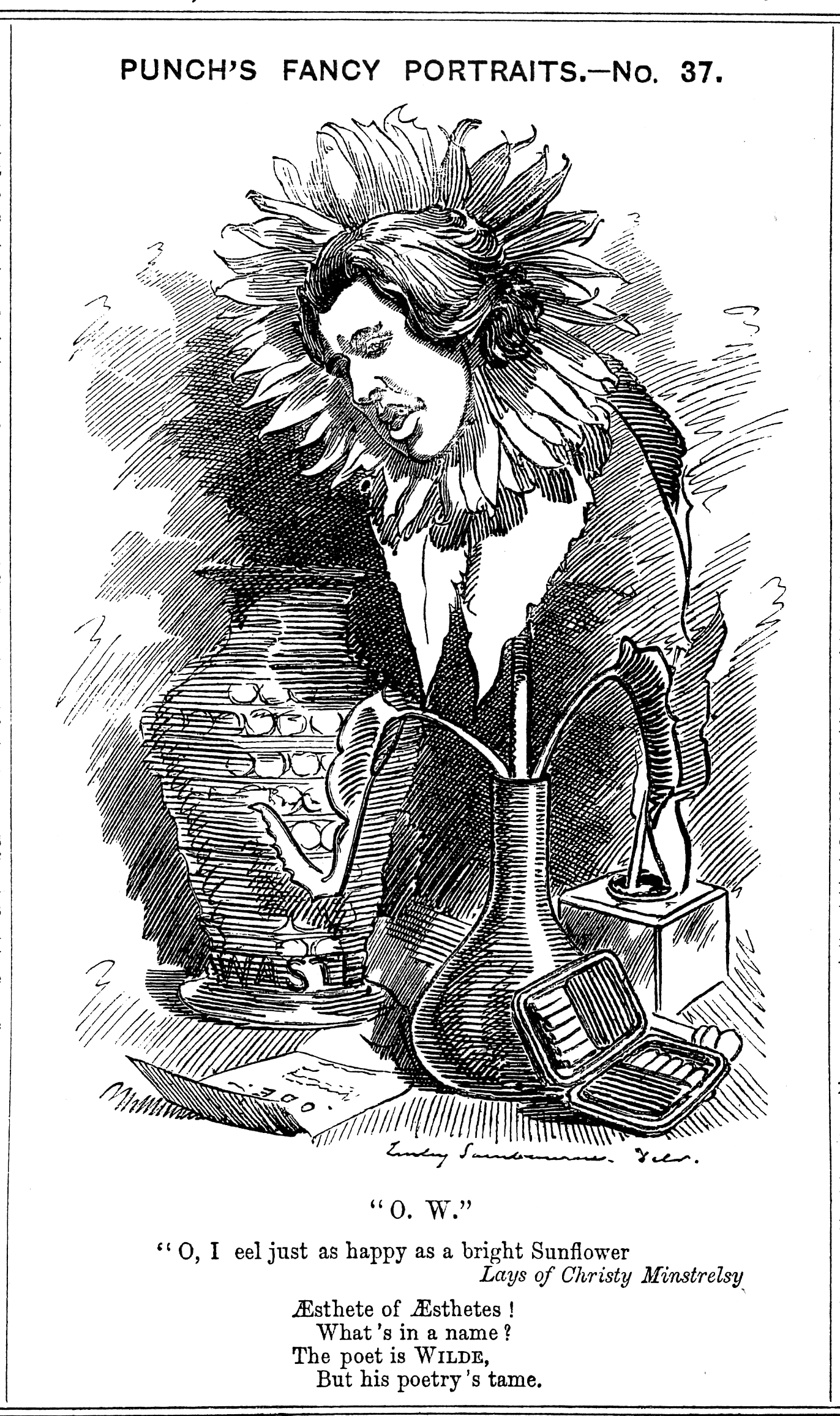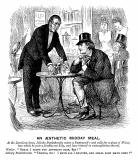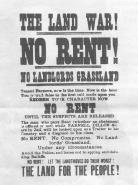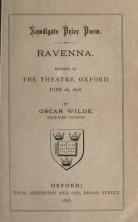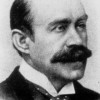Oscar Wilde Timeline
Created by Kenneth Daley on Fri, 08/27/2021 - 16:32
Timeline of events in Wilde's life
Timeline
Chronological table
|
Date |
Event | Created by | Associated Places | |
|---|---|---|---|---|
| Jun 1912 |
Tomb of Wilde installation
ArticlesEllen Crowell, “Oscar Wilde’s Tomb: Silence and the Aesthetics of Queer Memorial” |
David Rettenmaier | ||
| Dec 1908 |
Tomb for Wilde commission
ArticlesEllen Crowell, “Oscar Wilde’s Tomb: Silence and the Aesthetics of Queer Memorial” |
David Rettenmaier | ||
| Sep 1905 |
Silence
ArticlesEllen Crowell, “Oscar Wilde’s Tomb: Silence and the Aesthetics of Queer Memorial” |
David Rettenmaier | ||
| 30 Nov 1900 |
Death of Wilde
ArticlesEllen Crowell, “Oscar Wilde’s Tomb: Silence and the Aesthetics of Queer Memorial” Related ArticlesAndrew Elfenbein, “On the Trials of Oscar Wilde: Myths and Realities” |
David Rettenmaier | ||
| 1 Feb 1900 to 1 Feb 1900 |
St. James’s Theatre refurbishedAn excited audience filled the St James’s Theatre (King Street, London) on the first night following its complete refurbishment. The theatre's new telegraphic address, “Ruritania”, was a tribute to the play that paid for the lavish remodelling: George Alexander’s adaption of The Prisoner of Zenda (January 1896). Other plays staged at St. James’s included Arthur Wing Pinero's The Second Mrs Tanqueray (May 1893) and Oscar Wilde's The Importance of Being Earnest (February 1895). ArticlesRelated ArticlesRenata Kobetts Miller, “The Cultural Work of Drama Criticism in the Early 1890s” |
David Rettenmaier | ||
| 13 Winter 1898 |
The Ballad of Reading Gaol
Wilde wrote what ended up being his final published poem during his lifetime, titled “The Ballad of Reading Gaol”, while in exile in Berneval-Le-Grand, France, after his expulsion from prominent British society. The poem documented the ghastly conditions of his experience in prison at Reading Gaol, located in Reading, Berkshire, England, which was the popular name of a former prison, known officially as HM Prison Reading. Wilde was imprisoned here from 23 November 1895 until 18 May 1897 after being moved three other times following his conviction of gross indecency on 25 May 1895. During his imprisonment, a man named Charles Thomas Woolridge was hung for the murder of his wife, a scene which Wilde describes throughout the poem. Leading up to the release of the poem, Wilde understood that he was no longer attempting to impress the upper classes of society, and instead wished for it to be published in Reynolds Magazine, where he claimed that then it would be “read by his peers” who were now among “the criminal classes.” The poem, which was published by Leonard Smithers on 13 February 1898 under the name “C.3.3.”, which stood for cell block C, landing 3, cell 3, sold enough to give him some income until he died just over two years later. The epitaph on Wilde’s tomb was excerpted from the poem: “And alien tears will fill for him, Pity’s long-broken urn, For his mourners will be outcast men, And outcasts always mourn” Sources: Ellmann, Richard (1988). Oscar Wilde. New York: Vintage Books. Mason, Stuart, Bibliography of Oscar Wilde (1914, London) Mason, Stuart, Bibliography of the Poems of Oscar Wilde (1907, London) https://www.bl.uk/collection-items/the-ballad-of-reading-gaol-by-oscar-wilde |
Ezra Wallach | ||
| Dec 1896 to Mar 1897 |
Wilde Writes "De Profundus" While in PrisonWhile imprisoned for his "indecent" behavior with other men, Oscar Wilde wrote to his lover, Lord Alfred Douglas. The letter covers many topics, including their relationship, his imprisonment, much of the religious readings Wilde has done while incarcerated, and of course the grab bag of art, love, and societal ills that Wilde is known for tackling. But most importantly to the majority of scholars, it is a love letter. It took Wilde four months to write the letter. It was published in 1905, but with certain parts slandering Lord Douglas removed for fear of being sued. It was later republished in 1949 by his son Vyvyan, but even in this version was found some inaccuracies, perhaps due to the son's need to preserve a certain image of Wilde. It was finally published in full accuracy in 1962 by Rupert Hart-Davis. Some consider it to be the greatest love letter ever written. Source: https://www.bl.uk/collection-items/manuscript-of-de-profundis-by-oscar-w... |
Anthony Oleszkiewicz | ||
| The end of the month Spring 1895 to The end of the month Spring 1897 |
Oscar Wilde's Gross Indecency TrialOn May 25th, 1895, Oscar Wilde was put in prison for gross indecency. Queensberry (Sir John Sholto Douglas) accused him of having homosexual relationships with other men and Wilde tried to deny these claims by accusing Douglas of libel. When this backfired, he refrained from leaving England, stayed for his gross indecency trials, and ended up getting sentenced to two years in prison with hard labor. Before the trial began there were several events that familiarized England with acts of homosexuality. For example, as stated in source 5, the Cleveland street scandal revealed an event where aristocrats engaged in sexual activities with male brothels (Source 5). This event would be covered up by the English police department because of the aristocratic powerful men who were involved in the scandal. This event would also be referenced by the Scots Observer in their review of a Picture of Dorian Gray, which in the review subtly suggested that Oscar Wilde committed acts of gross indecency. Before the trial began, it is believed Wilde got romantically involved with Alfred Douglas, whose father, Sir John Sholto Douglas, found out and accused Wilde of sodomy. Queensberry told his son Alfred to stop all contact with Wilde or he’d “disown… and stop all money supplies” (Source 2). Queensberry provoked Wilde first by slipping him a note that said “For Oscar Wilde, posing sodomite” (Source 6). As a way to defend himself, he went on to convict Sir Douglas of libel. However, Douglas argued that Wilde solicited twelve men to commit sodomy with him between the years of 1892 and 1894, which the court seemed to sympathize with in the first trial. On the third day of the proceedings, Wilde's Lawyer found there was “abundant evidence of clients guilt” and he chose to withdraw from the case (Source 1). After the libel drama with Queensberry, Sir Edward Clarke, Wilde’s lawyer, “urged Wilde to drop the case” and flee to France until the drama over his public image dies down (Source 2). After failing to accuse Queensberry of libel, Wilde was accused of gross indecency, a very serious charge up until the late 1960s when England decriminalized same sex relationships. Wilde remained in England throughout the gross indecency trials. During this time, the lines from A Picture of Dorian Grey and Two Loves, such as “love that dare not speak its name,” were cross examined extensively (Source 1). While Oscar Wilde secured a mistrial on his first trial, during the second trial, beginning on May 21st, Oscar Wilde was convicted of gross indecency. Despite many potential witnesses not betraying Wilde, the jury found Wilde guilty and the judge punished Wilde to the greatest degree he could; two years in prison with hard labor and no bail. What Source five argues however, is that the court didn’t have adequate evidence to charge Oscar Wilde. The source argues that Wilde was found guilty upon speculation that he committed gross indecency, while in actuality writing about homosexual desires inside a novel isn’t conclusive proof that one actually committed sodomy upon another person (Source 5). By the time Oscar Wilde got out of prison on May 19th of 1897 he was exiled to France and died there three years later at age 45 in poverty. Sources:
|
Elliott Dynes | ||
| Apr 1895 to May 1895 |
Trials of Oscar Wilde
ArticlesAndrew Elfenbein, “On the Trials of Oscar Wilde: Myths and Realities” |
David Rettenmaier | ||
| The middle of the month Winter 1894 to Winter 1899 |
"The Importance of Being Earnest"Known as Wilde's most famous play, The Importance of Being Earnest premiered at St. James's Theatre in London on 14 February 1895. Wilde began meticulously outlining and drafting the comedy in July 1894. He continued revising the play over the course of six months. The most notable change is when George Alexander, the manager of St. James’s Theatre, advised Wilde to cut the four-act play down to three acts. Thus, the satirical tale of double lives in Victorian society was born. The comedy’s success was disrupted by the trials of Oscar Wilde. The night of the first production served as the catalyst to the trials thanks to the appearance of the Marquess of Queensberry, as Wilde was in a relationship with the Marquess's son. Wilde heard of the Marquess' intention to present him a bouquet of rotten vegetables, so he refused to take a bow. Although Wilde managed to avoid the Marquess that night, the Marquess' continuous threats lead to a legal feud. Due to the publicity about Wilde’s homosexuality, his name was omitted from the programme starting 6 April 1895, and the play was officially closed by 8 May 1895 after 83 performances. In February 1899, the first edition of The Importance of Being Earnest was published by Leonard Smithers and Co. Articles and Sources: Raby, Peter. The Cambridge Companion to Oscar Wilde. Cambridge, U.K.; Cambridge University Press, 1998. Print.
|
Vivian Nguyen | ||
| 1892 |
Lady Windermere's FanLady Windermere's Fan is a four-act play written by Oscar Wilde that was first performed in 1892 and then published a year later. The play is a "comedy of manners", which means that it has satirical aspects that reflect the manners of society. The play is about Lady Windermere and her jealousy over her husband's interest in Mrs. Erlyanne, who we eventually find out is Lady Windermere's long-lost mother. Wilde used his works in order to highlight and reflect what was happening in Victorian society, usually in satirical ways. After numerous flops with writing play in the past, Wilde tried his hand at comedy. The result was Lady Windermere's Fan, and after it was performed it got raving reviews. |
Mackenzie Warren | ||
| Summer 1891 to Autumn 1897 |
Relationship with Lord Alfred Bruce DouglasIn June of 1891, Wilde met Lord Alfred Bruce Douglas. Lord Douglas was the third son of the 9th Marquess of Queensberry and an undergraduate student at Oxford at their first meeting. As both were literary talents, they were drawn to each other and started an affair. Despite Lord Douglas's position as a noble, Wilde would indulge in his lover, eventually outspending the amount that he made. The two would often meet up together and would even go on trips. In January 1895, they went to Algiers together. Wilde began writing more frequently to try and make up his debt due to the expensive relationship. One of the products of this time would eventually become The Importance of Being Earnest. The 9th Marquess of Queensberry knew of Wilde and his son's closeness and repeatedly sent threats. When he sent Wilde a note calling Wilde a "posing Somdomite," which is a misspelling of Sodomite. Wilde responded to Queensberry's words by accusing the Marquess of libel and sparking legal trials. Oscar Wilde's trials in 1895 caused a rift in their relationship as Wilde was imprisoned and spent a few years abroad after he was released. Yet, Wilde continued to write letters to Lord Douglas throughout the years. The two reunited in August 1897 in Rouen, but parted ways for good a few months later.
Articles and Sources: Harris, Frank. Oscar Wilde: His Life and Confessions. United States, Brentano's, 1916. Wilde, Oscar, and Merlin Holland. Oscar Wilde: A Life in Letters. Carroll & Graf, 2007.
|
Vivian Nguyen | ||
| 1891 |
“A House of Pomegranates” Is PublishedA House of Pomegranates is a collection of fairy tales, written by Oscar Wilde, that was published as a second collection for The Happy Prince and Other Tales (1888) by James Osgood McIlvanie in London. The stories in this collection are: The Young King, The Birthday of the Infanta, The Fisherman and his Soul, and The Star-Child. Each of these stories are heartbreaking in their own ways; each feels like a fairy tale: mystical. They have themes that are reminiscent of themes (souls, influence, and spirituality) in his book, “The Picture of Dorian Gray.” In a review by the Pall Mall Gazette (dated 1891), the reviewer questioned whether or not Wilde wrote this for the average British child because the themes in these short stories were not suitable for young children; they mentioned that an “unpleasant suggestion [of the text] reminds us of ‘Picture of Dorian Gray’.” In response, Wilde said to the editor of the Pall Mall Gazette that in writing this collection, he "had about as much intention of pleasing the British child as [he] had of pleasing the British public,” meaning he didn’t write this for either children or the British people. sources: https://worldhistoryproject.org/1892/a-house-of-pomegranates-is-published https://link.gale.com/apps/doc/ZIIBXR379551706/LCO?u=uiuc_columbia&sid=bookmark-LCO&xid=0c5a71d7 |
vic peralta | ||
| 19 Jul 1890 |
Punch ArticleThe satirical magazine Punch publishes an article entitled "Our Booking Office" lampooning Dorian Gray. Wilde is very offended. Animosity between Wilde and the Punch staff is born. |
Quinn Chisenhall | ||
| Jul 1889 |
'The Portrait of Mr. W. H.' is PublishedFirst published by Blackwood's Edinburgh Magazine, 'The Portrait of Mr. W. H.' follows the obsession of trying to figure out who the name of this person, known only by his initials, to whom Shakespeare dedicated the first edition of his Sonnets (1609). It plays off the theory by Thomas Tyrwitt in 1766 that the identity of the man is Wil Hughes, an actor in Shakespeare's company. The character's need to believe their theory is correct drives them to extreme lengths, going as far as to commission a fake portrait of Will Hughes to admire, and expresses themes of exhausted passions for ideas. At the time of publication, the short story was controversial for its homoerotic nature of men's adoration for another. Involving Shakespeare in the homosexual subtext of the story also made it controversial and stopped its publication with Elkin Matthews before it could be released in 1893. The manuscript was lost for years, until its resurfacing and publication in 1921, America. |
Samantha Loree | ||
| 1889 to 1891 |
"The Picture of Dorian Gray" Context & BackgroundOscar Wilde wrote his only novel, The Picture of Dorian Gray, at the invitation of the American publisher, J. M. Stoddart, managing editor of the Lippincott’s Monthly Magazine, who on 30 August 1889 gave a dinner in London at the Langham Hotel for Wilde and Arthur Conan Doyle. When Stoddart asked for a piece twice as long as Wilde’s fairy tale ‘The Fisherman and his Soul’, Wilde began working on The Picture of Dorian Gray. Stoddart's offer was attractive to a comparatively unknown author such as Wilde, whose literary career was not overwhelmingly successful at that time. J.B. Lippincott & Co. was one of the largest book publishing firms in Philadelphia and Lippincott’s Monthly Magazine a well-established American literary periodical that wished to increase its share of an expanding transatlantic market. Lippincott published their literary magazine from 1868 to 1915, and it included literary reviews, poetry, and short stories. In addition to Wilde, works by authors such as Rudyard Kipling, and Arthur Conan Doyle were published as well. In the summer of 1890, when the first edition of the novel was published in Lippincott's Monthly Magazine, the novel contained 13 chapters, and was criticized as scandalous and immoral (with detractors condemning its homosexual undertones and seeming embrace of hedonistic values.) Disappointed with its reception, Wilde revised the novel in 1891 and published it as a single volume, issued by Ward, Lock & Co (the London publisher which circulated the British edition of Lippincott's), adding a preface and six new chapters. This Preface was written as a response to those unkind critics of the first edition. It also succinctly sets forth the tenets of Wilde's philosophy of art. Devoted to a school of thought and mode of sensibility known as aestheticism, Wilde believed that art possesses an intrinsic value - that it is beautiful and therefore has worth, and thus needs serve no other purpose, be it moral or political. This attitude was revolutionary in Victorian England, where popular belief held that art was not only a function of morality but also a means of enforcing it. Articles: |
Shalyn Delhaes | ||
| Spring 1888 |
“The Happy Prince and Other Tales” is PublishedOscar Wilde writes his first book of fairy tales. It's titled, "The Happy Prince and Other Tales", and it is a collection of stories for children first published in 1888 by the London publishing company, Duckworth and Co. Its stories include: "The Happy Prince,” "The Nightingale and the Rose," "The Selfish Giant," "The Devoted Friend,” and "The Remarkable Rocket.” Each story is fantastical, full of imagery, and lessons that Wilde wanted to pass on. In a Review section of The Burlington Magazine for Connoisseurs (Vol. 24, No. 129 published in the December of 1913) written by “Various Reviewers,” Wilde’s book of tales was said to be a “success” and should be bought in time for a collection of “Christmas books.” In that year of the review, it had been republished by Duckworth and Co. with colored illustrations and a new book cover. sources: https://www.gradesaver.com/the-happy-prince-and-other-tales/study-guide/summary https://www.google.com/books/edition/The_Happy_Prince_and_Other_Tales/ltmeSDZOPHAC?hl=en&gbpv=0 |
vic peralta | ||
| 1887 to 1889 |
New Editor of "The Women's World"In April of 1887, Oscar Wilde became the edition of "The Lady's World," which later became titled "The Woman's World." The original print, "The Lady's World," was "a very vulgar, trivial and stupid production' in Wilde's world. When he became an edition, his first matter on the agenda was to change it to what it is known today of "The Woman's World." Wilde promised that he would work during the duration of his editorship to have the magazine "take a wider range as well as a high standpoint and deal with merely with what women wear but with what they think and feel'. And that is what Wilde did. Wilde noticed him primarily due to the need to have a regular income. He was, in a sense living out of his reasonable means, so he took on the role as a way to fund it. Another modification is that he believed that women have an entire identity outside the patriarchal society, which he held as an individualist. According to the Oxford dictionary, individualism is defined as advocating for people's free and independent actions in both economic and social affairs. Wanting to correct the mistakes of the past editors of the magazine, he worked to bring forth bring the narrative of what women were dealing with, education and employment, politics, and literature. Commission different woman authors for the magazine written for women and others to consume made by women. This was, during its time, a scarce thing to find within magazine culture. Sources: https://worldhistoryproject.org/1887/oscar-wilde-is-appointed-editor-of-... Entering "The Woman's World": Oscar Wilde as Editor of a Woman's Magazine (victorianweb.org) |
Jalen Isley | ||
| 14 Aug 1885 |
Criminal Law Amendment Act
Related ArticlesMary Jean Corbett, “On Crawford v. Crawford and Dilke, 1886″ Andrew Elfenbein, “On the Trials of Oscar Wilde: Myths and Realities” |
David Rettenmaier | ||
| 29 May 1884 |
Marriage to Constance LloydOn May 29th, 1884 Oscar Wilde married Constance Lloyd, the daughter of Horace Lloyd, a Queen's Council member. The two had two children together, Cyril (1885) and Vyvyan (1886). Wilde's family did not necessarily approve of Constance, as she only got an allowance of £250 a year, which would later increase to £900 after her grandfather died. Oscar lived an extravagant life, and the financial strain was one of many problems in their relationship. Wilde was reportedly "disgusted" with Constance's body after her pregnancies. Despite all of this, Wilde continued to support Constance in her endeavors. Nobody knows when Constance found out about her husband's homosexual extramarital activities, but in 1891 she met Wilde's lover Lord Alfred Douglas. She visited him in prison, paid his fees, and planned for a reunion later. However, after the scandal, she fled to Switzerland with her sons and changed their last names to Holland. (Citation: Kelly, Jennifer. "Oscar Wilde (16 October 1854-30 November 1900)." British Reform Writers, 1832-1914, edited by Gary Kelly and Edd Applegate, vol. 190, Gale, 1998, pp. 360-370. Dictionary of Literary Biography Vol. 190. Gale Literature: Dictionary of Literary Biography, link.gale.com/apps/doc/MALMFA511353148/DLBC?u=uiuc_columbia&sid=bookmark-DLBC&xid=77f38bf7. Accessed 20 Oct. 2021. https://www.theguardian.com/books/2011/jun/24/constance-mrs-wilde-franny...) |
Mickayla Whitt | ||
| 2 Jan 1882 to The middle of the month Oct 1882 |
American TourAfter publishing his first poetry book, Oscar Wilde was asked to tour in America. The tour started on January 2nd, 1882 in New York City. Originally intended to be only four months long, the tour ended up being extended to almost an entire year due to its popularity. He lectured mostly on his views of poetry and aestheticism with titles such as ‘The English Renaissance’ and ‘The Decorative Arts’ I and II. Within his lectures, he tried to allude to certain parts of whatever city he was in. When he was in Chicago he gave the lecture ‘Decorative Arts’ which focused on civic beauty and architecture. In his lecture, he called the Chicago water tower “a castellated monstrosity with pepper boxes stuck all over it,” which naturally upset the citizens of Chicago yet he was welcomed back and lectured there another night a couple of months later. Throughout his tour, Wilde was one of the first to use the press in a way that would launch him to celebrity status and thus launch his career. He managed to get more press coverage in America than Queen Victoria. W.S. Gilbert wrote ‘Patience,’ which featured a “grandiose boob” who was partially modeled after Oscar Wilde. On his US tour, Wilde’s publicist worked with W.S. Gilbert to get the play up in popularity with the Americans. In order to do this Wilde dressed similarly to the character and he illustrated aestheticism which was what ‘Patience’ was trying to satirize. While doing this, American’s became fascinated with Wilde and he was promptly invited to houses of some of the “celebrities” of the time, such as Walt Whitman. Sources https://www.thefamouspeople.com/profiles/oscar-wilde-63.php https://www.nytimes.com/2014/12/07/books/review/wilde-in-america-by-david-m-friedman.html https://www.nytimes.com/1985/07/03/arts/gilbert-and-sullivan-s-patience.html https://www.oscarwildeinamerica.org/lectures-1882/oscar-wilde-lecture-titles.html |
Enias White | ||
| Spring 1881 to 23 Summer 1881 |
Publishing of PoemsIn mid-1881 at age twenty-seven, Wilde published his first collection of poems, simply entitled Poems. The collection was not received well at first, earning him a caricature in Punch, a satire and humor magazine in the 1800s. It was not only judged by critics, but readers as well, "Most readers were eager to denounce Wilde on the grounds of imitation of various writers and his ornate language" (Kelly 363).
Following the publication of Poems, Punch released a review of the collection as well, in which they stated, "Mr. Wilde may be aesthetic, but he is not original." Most criticism readers agreed with Punch's statements. (Citations: Kelly, Jennifer. "Oscar Wilde (16 October 1854-30 November 1900)." British Reform Writers, 1832-1914, edited by Gary Kelly and Edd Applegate, vol. 190, Gale, 1998, pp. 360-370. Dictionary of Literary Biography Vol. 190. Gale Literature: Dictionary of Literary Biography, link.gale.com/apps/doc/MALMFA511353148/DLBC?u=uiuc_columbia&sid=bookmark-DLBC&xid=77f38bf7. Accessed 20 Oct. 2021. Internet Archive. 1881. Punch Vol -lxxxi: The Office London: Free Download, Borrow, and Streaming: Internet Archive. [online] Available at: <https://archive.org/details/in.ernet.dli.2015.207182/page/n33/mode/2up> ) |
Mickayla Whitt | ||
| Oct 1880 |
Punch Cartoon Satirizing AestheticismThe cartoon by George Du Maurier, posted here, made fun of Aesthetics. It provides us with a primary source illustrating the attitudes Wilde was subjected to after publishing Dorian Gray. |
Quinn Chisenhall | ||
| 1879 |
The Irish Land LeagueThe Irish Famine of 1879, while at a smaller scale than the Great Famine’s of 1740 and 1845, had dire effects on tenant farmers, especially in western districts. Heavy rains, low crop yields, and few opportunities for outside income made rent unaffordable and eviction a looming threat. The Irish Land League, a land agitation and tenants rights movement, was thus founded and led by Charles Steward Parnell, Michael Davitt, Andrew Kettle and Thomas Brennan. The movement sought to achieve for tenant farmers the security of tenure, fair rents, freedom to sell property, and ultimately, for peasants to have sole ownership of the land. Oscar Wilde would have already settled into London by Autumn of 1879, taking a room with painter and Oxford friend Frank Miles. The Wilde’s origins in western Ireland are rooted in the late 1740s, when Ralph Wilde, Oscar’s great-grandfather, landed in Castlerea, which is a small town in the County Roscommon (Hanberry, 1). Following the death in 1876 of Oscar’s father, Sir William Wilde, the family was virtually bankrupt; what few properties were left (one being their holiday home in Illaunroe) would be made unprofitable amidst the early developments of the Land League. In a letter to Oscar, Lady Wilde wrote, ‘How are we all to live? It is all a muddle. My opinion is that all that is coming to us will be swallowed up in our borrowings before we are paid.’ Despite spending the majority of his adult life outside of Ireland, he and his family remained strong proponents of both the Land League and the greater cause of Irish Nationalism. In an interview with The Pall Mall Budget, at the time when his play Salomé, was being reviewed by the London theatre censor, Wilde stated, “I am not English; I’m Irish — which is quite another thing.” Sources: HANBERRY, GERARD. “Discovering Oscar Wilde in the Heart of Galway.” The Wildean, no. 44, Oscar Wilde Society, 2014, pp. 96–103, https://www.jstor.org/stable/48569044. Tóibín, Colm. “‘The Road to Reading Gaol." London Review of Books, London Review of Books, 27 Nov. 2019, https://www.lrb.co.uk/the-paper/v39/n23/colm-toibin/the-road-to-reading-.... “Wilde, Oscar Fingal O'Flahertie Wills (1854–1900).” Oxford Dictionary of National Biography, https://www.oxforddnb.com/view/10.1093/ref:odnb/9780198614128.001.0001/o.... “The Censure and Salomé: An Interview with Mr Oscar Wilde,” Pall Mall Budget, 30 June 1892, p. 947. |
Adiam Woldu | ||
| Dec 1878 |
Bram Stoker Marries Florence BolcombWilde had been courting Balcomb, whom George de Maurier called, "One of the three most beautiful woman in England," for several years before Stoker, who knew Wilde from Trinity College, married her suddenly. Wilde would continue to write to her, sometimes anonymously. This event kicked off a (at first unreciprocated by Stoker) rivalry between the two men. |
Quinn Chisenhall | ||
| 1878 |
Awarded the Newdigate PrizeIn Wilde’s final year as a student at Magdalen College at Oxford, he was awarded the Newdigate Prize for his poem “Ravenna”. Established in 1806 as a memorial for Sir Roger Newdigate, The Newdigate Prize is awarded to an Oxford undergraduate for the Best Composition of English verse. Wilde’s seven-part poem is an ode to the titular Italian city, describing a young man’s recollection of experiences. At the start of the poem, the protagonist is excited to view the titular Italian city that was “Where Dante sleeps, where Byron loved to dwell”. Throughout, we follow his observations as he realizes that the city has lost some of its vibrance, yet still retains its beauty as a “poet’s city”. Reciting the poem to an audience upon his reception of the Newdigate Prize was his first introduction to the world outside of Oxford and from here, he began to receive public notoriety. Sources Vernier, Peter. “‘NEWDIGATE’ PHOTOGRAPHS OF OSCAR WILDE.” The Wildean, no. 10, Oscar Wilde Society, 1997, pp. 49–61, http://www.jstor.org/stable/45270277. https://worldhistoryproject.org/1878/oscar-wilde-is-awarded-the-newdigat... |
Deanna Whitlow | ||
| Feb 1873 |
Studies in the History of the Renaissance
ArticlesRachel Teukolsky, “Walter Pater’s Renaissance (1873) and the British Aesthetic Movement” |
David Rettenmaier | ||
| 1871 to 1874 |
Attended Trinity College in DublinWilde went from Portora Royal School to Trinity by using the Royal School Scholarship. He won other awards and scholarships for his outstanding academic achievments. One of his awards was the Berkely Gold Medalthat he later pawned off multiple times. There he met John Ruskin and Walter Pater. They influenced his eduction with Ruskin's moral medievalism views and Pater's Renaissance beuty views. https://worldhistoryproject.org/1871/oscar-wilde-attends-trinity-college... |
Bennett Frese | ||
| The middle of the month Autumn 1854 |
Wilde's BirthOscar Fingal O'Flahertie Wills Wilde was bron on 16 October 1854 at 21 Westland Row, Dublin, Ireland. |
Kenneth Daley |

